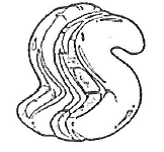The Court of Appeal of Arnhem/Leeuwarden, The Netherlands, in its decision of August 21, 2018 invalidated the Benelux trade mark registration of the so called S-shape for loosefill packing material (see below picture) because it consists exclusively of a shape that is necessary to obtain a technical result.
The Court of Appeal applied the principles established by the Court of Justice in Philips/Remington (C-299/99), Lego/OHIM (C-48/09) and Nestlé (C-215/14). The Court first established that the packing material for which the S-shape is registered consists of polystyrene packing peanuts in the shape of an S. As shown by the sales information produced by the trade mark owner, the packing peanuts are used to package products (including fragile products) in boxes and to fill up such boxes. From the assertions made by the parties, the Court of Appeal concludes that the intended technical effect of the packing material is to prevent the packaged products from shifting easily inside the boxes. The Court of Appeal then discussed what the essential characteristics of the mark are. The mark consists of the picture of packing material in a S-shape and showing lines with grooves and serrations while the impression is made that the mark consists of several S-shapes piled on top of one another. The Court of Appeal found that the grooves and serrations are a direct consequence of the production technique used by the trade mark owner and that even just for that reason alone the grooves and serrations and the lines they create cannot be regarded as non-functional decorative or imaginative elements. The Court of Appeal also finds that the grooves and serrations are of minor importance when considering the mark as a whole. The fact that the grooves and serrations differ for each peanut tends more to give the impression that this is a property of the material rather than an important distinguishing decorative element. In the Court of Appeal’s view this also applies to the optical effect that the S shape consists of several S shapes piled on top of one another.
With respect to the S-shape itself, the conclusion is that this shape is functional for packing material. In reaching this conclusion the Court of Appeal referred to a US patent that describes among others the interlocking possibilities of an S shape and their advantages. Furthermore the Court concluded that it follows from the sales information of the trade mark owner as well as independent dealers that the S shape contributes to the usability advantages of the packing material. These materials talk about the settling capacity of the product, which means that the packed goods stay in place well.
The Court of Appeal therefore decided that (because the S-shape, whose essential feature, the S, is inherent to the generic function of the packing material, being the packaging of products (including fragile products) such that they are resistant to shocks and shifting in transit) awarding trademark protection to the S shape would hinder competing businesses from utilising the technical and usability advantages of the S in an unacceptable way.
The plaintiff in this matter was represented by Charles Gielen, NautaDutilh NV, Amsterdam.
_____________________________
To make sure you do not miss out on regular updates from the Kluwer Trademark Blog, please subscribe here.
Kluwer IP Law
The 2022 Future Ready Lawyer survey showed that 79% of lawyers think that the importance of legal technology will increase for next year. With Kluwer IP Law you can navigate the increasingly global practice of IP law with specialized, local and cross-border information and tools from every preferred location. Are you, as an IP professional, ready for the future?
Learn how Kluwer IP Law can support you.



